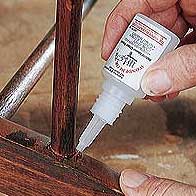
This woodworker keeps trying to fix a kitchen chair’s rungs and supports with no luck. He takes them apart, reglues them and they keep falling apart. Is there something he can buy that would be better than glue?
Michael Dresdner: I’ve seen chairs made with softwood-turned stretchers set into softwood posts. While hardwood will work in this format, softwood usually won’t. The combination of a very small effective gluing area on the turned stretcher combined with the large amount of wood movement makes it a no win situation. The other possible problem is that the design of the chair simply does not allow enough structural support or glue area for the chair to do its work. No glue ?or hardware ? will overcome poor design for long.
Ellis Walentine: We’ve had several discussions of this on the WoodCentral messageboards in the past. The consensus from the experts is that you want a reversible glue, such as hot hide glue. Don’t waste your money on those watery products that you inject into the joint to swell the tenon; they don’t last.
Simon Watts: Sounds to me as if the time has come to drill the holes out, expose new, clean wood and then make new rungs and/or stretchers to fit.
Ian Kirby: A round wooden peg in a round wooden hole doesn’t have a lot of glueing area at best ? it’s no surprise you have a high failure rate. You might try epoxy. Get any loose particles, finish, old glue and crud off both parts, and be sure to wet every contact part. Paddle the epoxy on with a stick, preferably a tongue depressor. Or you could drill a hole for a screw in the hole and drill a pilot hole in the end grain of the rung. Try a round head screw with a small washer and make a feature of the repair.





